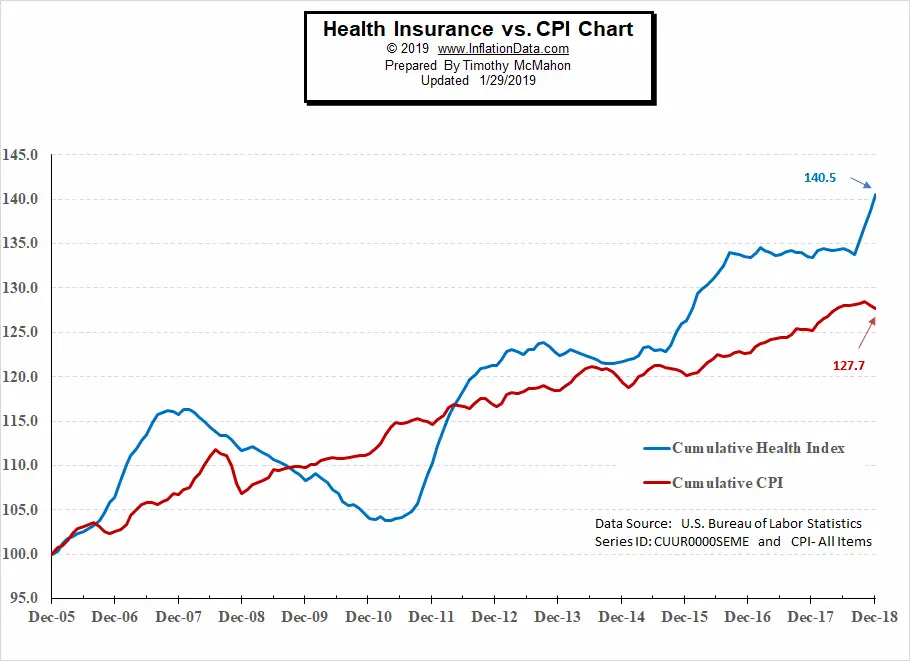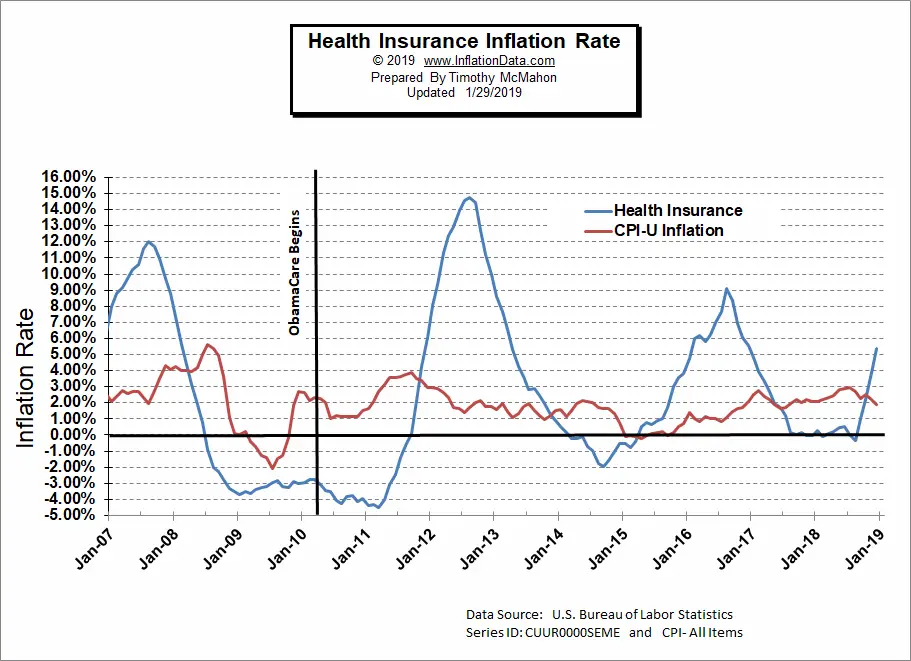What is Inflation and How does it Impact Insurance?
Well, to understand the effects that inflation has on insurance, it is crucial to understand what inflation is. Generally, there are two types of inflation “Price inflation” and “Monetary inflation” (i.e. an increase in the money supply). Price inflation is primarily caused by monetary inflation. In this article, we will use the common meaning of inflation and refer to Inflation as a general rise in prices.
To understand inflation’s impact on insurance, we must first understand that insurance is a monetary instrument i.e. a contract generally between an individual and a company that involves a series of small payments from the individual to the company in exchange for a potentially large payment from the company to the individual sometime in the future.
Being a financial instrument over a longer duration of time, inflation can have more of an impact than a one-time transaction in the present. Obviously, there are a variety of different types of insurance including life, disability, health, auto, homeowners, mortgage, long-term care, etc. Some of which have a short duration i.e. renewable annually and others can last for decades.
Life Insurance and Inflation
One of the easiest ways to see the effects of inflation is in life insurance because of the longer duration of the policy.
Life insurance is composed of two parts, the premium which is typically paid annually and the benefit which is typically paid upon the death of the insured many years after the policy was originally issued.
We will use nice round numbers for this example, (they in no way indicate actual insurance costs since life insurance rates vary due to age, health, and other risk factors). We will also use a ‘term-life insurance’ policy since it is pure insurance without any saving or investing provisions. Let’s assume that a 30-year-old male purchases a $100,000 term life insurance policy for $1,000 per year. This means that after 30 years he will have paid in a maximum of $30,000 for basic life insurance coverage. If he dies during that period his heirs will receive $100,000 but if he lives he gets nothing but peace of mind.
Since this is a contract the amount of his payments to the insurance company is fixed at $1000 so even though the purchasing power of the dollar is decreasing over the 30 years due to inflation the buyer doesn’t have to pay more for the coverage. So as time goes on, he gets to pay with “cheaper dollars” thus his insurance coverage gets cheaper over time. But conversely, his benefit also loses purchasing power. Typically, over thirty years the purchasing power of $100,000 might fall to the equivalent of $50,000 or even only $30,000. Of course, he could buy an additional “rider” to help protect against the ravages of inflation in addition to the life insurance itself. He could also buy a rider (for an additional fee of course) that will return his payments should he not die during the entire coverage period.
If an insurance company risks paying out $100,000 and only gets $30,000, how can that be a good business model?
First of all, not everyone dies during the period the policy is in force. Insurance companies hire actuaries whose job it is to make sure that the death rate allows them to make a profit. So if one out of four died they would have taken in $120,000 and spent $100,000. of course, it is much more complicated than that because some people will die after a single payment and others will live the entire period without dying. Plus, many will cancel their policy after paying for several years, but before they die. Although the company can’t tell which individuals will die during a given period, they can very accurately estimate what percentage of thousands of policyholders will die. Thus making life insurance a very profitable business.
In addition, life expectancies are getting longer making it less likely that the insurance company will have to payout. Plus the insurance companies are able to invest the money in the interim and earn additional money while they are waiting for a percentage of the policyholders to die.
Inflation Protection Insurance
In order to keep up with the rates of inflation, policyholders can purchase a feature known as “insurance inflation protection” where the value of benefits will rise by a pre-set percentage over a set period of time. This is especially beneficial for individuals looking to purchase long-term insurance policies like life or long-term care (which is bought years in advance of when it needs to be used).
Inflation protection can also be handy in situations where an individual needs to purchase disability insurance but worries about inflation affecting the costs of medical care decades down the road. Without this particular policy feature, these costs may exceed their existing insurance coverage limits. Insurance inflation protection is handy because it mitigates the effects of these increased costs.
As with any additional riders, insurance inflation protection is a feature you can add on to an existing policy for additional costs that directly impact premium prices. It is important to note as well that inflation protection insurance does not exempt the policyholder from having to face premium increases unless premiums are locked in for the life of the contract.
Health Insurance and Inflation
Due to rising health care costs, health insurance has become more of an issue in recent years than it was in years past. Insurance was such a non-issue that the U.S. Bureau of Labor Statistics didn’t even begin tracking insurance costs separately until 2005 (when they set the index equal to 100). On the chart below, we can see the annual percentage increase of health insurance compared to the Consumer Price index (i.e. the average inflation of all consumer items). Obviously, some years health insurance costs increased much more than the average item.
With the variation sometimes being above the CPI and sometimes below it is difficult for the naked eye to determine whether health insurance is higher or lower than average in the long term. So, we need to look at cumulative prices to get the full picture.
 From the above chart, we can see that there is only a brief period where general CPI prices (red line) are above the health insurance prices so since December 2005 health insurance costs have increased much more than the cost of average items.
From the above chart, we can see that there is only a brief period where general CPI prices (red line) are above the health insurance prices so since December 2005 health insurance costs have increased much more than the cost of average items.
Home Owners Insurance and Inflation
Home insurance policyholders are affected by the rate of inflation in many ways. The most obvious effect is the rise in the cost of the insurance itself. This is driven by the inflation of labor and repairs costs. As it costs more to repair or replace a damaged home insurance companies must raise the rates they charge for coverage. These costs are very location-specific, so home insurance rates also vary dramatically from location to location. For instance, local construction costs, burglary rates, frequency of flooding and hurricanes, local building codes, and even proximity to a fire station all affect local insurance rates.
So homeowners insurance in New York City will be vastly different than in Tulsa, Oklahoma, and factors in Alberta will lead to entirely different Calgary home insurance costs than in Montreal, Toronto or Halifax.
Even if policy prices don’t increase for a specific amount of insurance coverage, you might still be subject to needing higher levels of coverage. Because as prices for materials and repairs increase and as your home’s value increases due to inflation you may be underinsured. Then if anything happens to your home the cost of damages and repairs may exceed your policy’s limits, so it may be necessary to increase your policy coverage limits.
Conclusion
Inflation can affect the cost of insurance through a variety of different factors. For instance, individuals or families with homeowner’s insurance may be subject to higher premiums during periods of higher inflation due to rising costs of labor and materials. However, inflation is only one of many factors which contribute to fluctuation in insurance costs. But in addition to the cost of insurance policyholders need to keep an eye on the value of the coverage as well, since over-time coverage can become inadequate due to the effects of inflation.
You might also like:



This is really helpful, more information about home insurance.
Thanks for sharing!
I found it beneficial that you brought to light that inflation can affect the cost of insurance because those with certain kinds can be billed differently. My spouse and I are interested in purchasing health insurance for our teenaged daughter, but we do not know what steps to take. We’ll be sure to do it as soon as possible!